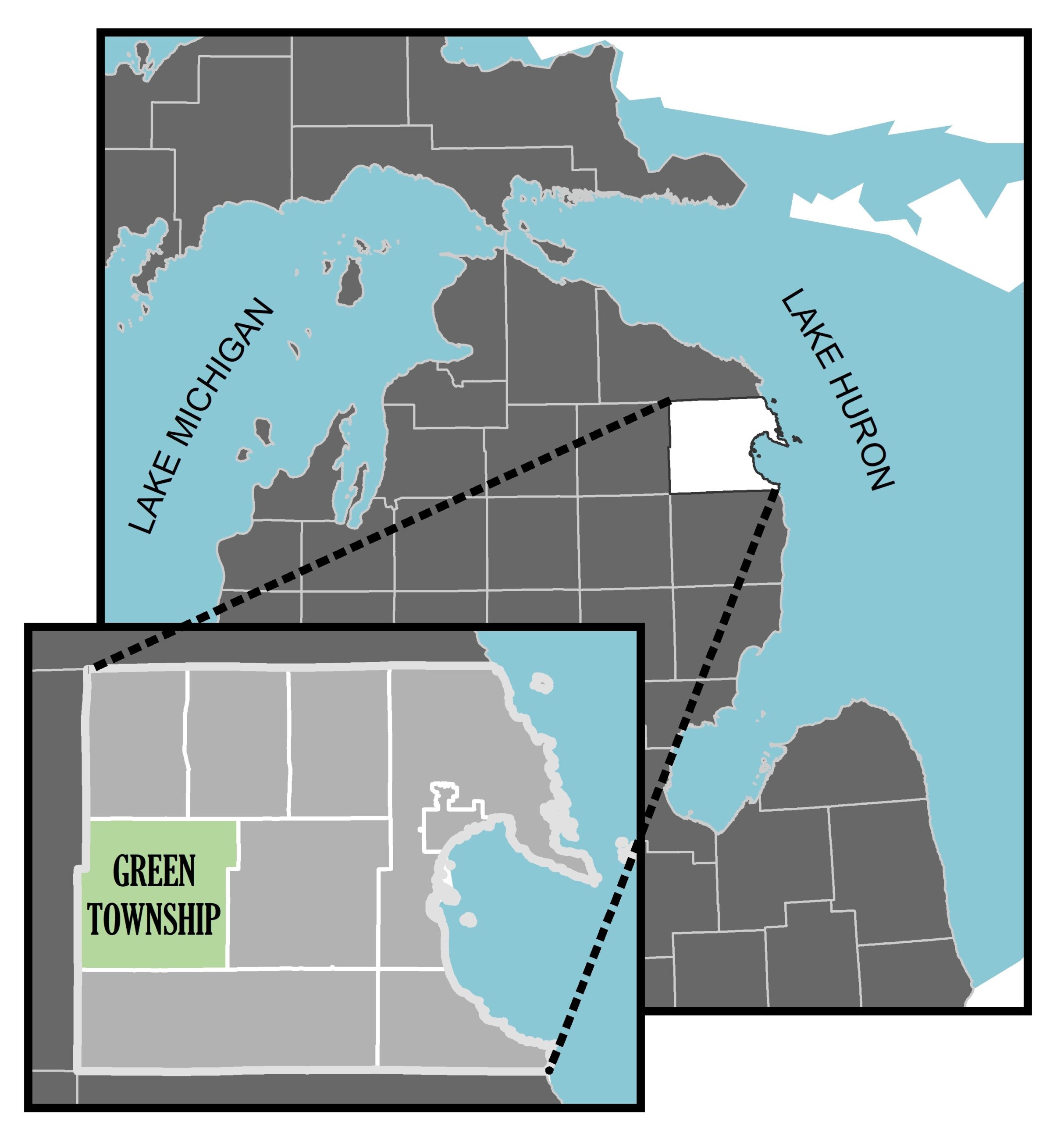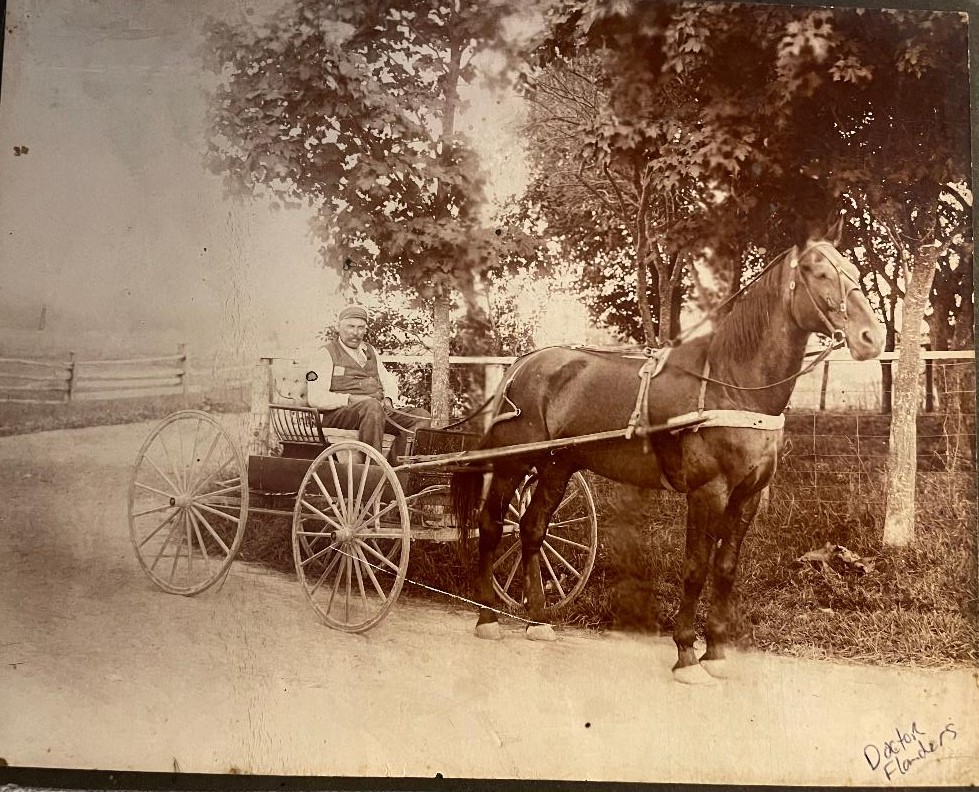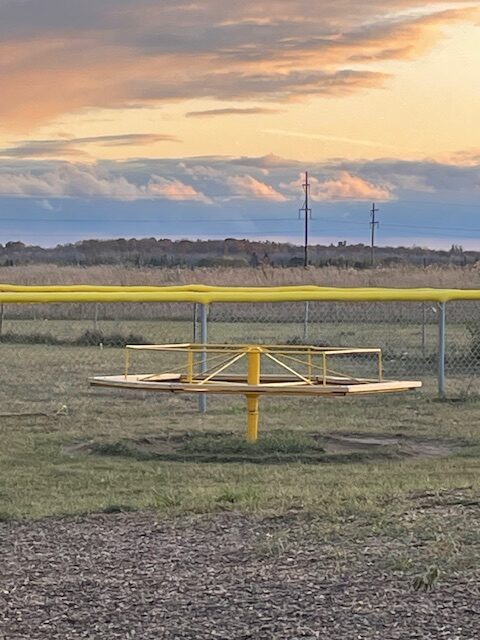Green Township History
Green Township is located in the South half of the west side of Alpena County in Northeast Michigan. It was established March 26, 1881 by the Alpena County Board of Supervisors. Green Township stretches now from the east and west boundaries of Wilson Township (along Bean Creek to the Montmorency County border at the Thunder Bay Golf Course near Hillman on M-32) and from the south and north boundaries of Beaver Lake Road off M-65S to just north of Green Road located off M-32.
Settlements that were established before it was officially organized as Green Township
THE SETTLEMENT OF GREELY
In 1867, Charles Greely and George Erskine came from Alpena and settled in the area of what is now known as the M–32/M-65 South intersection. They homesteaded 160 acres and cleared over 100 acres of land to begin farming turnips and potatoes. An additional 40 acres were added by 1871. George Erskine’s wife went to Maine to visit her mother and died there along with the baby. Mr. Erskine was grief-stricken and therefore moved back to the City of Alpena. Mr. Greely stayed on the farm where the Greely House was built in 1875 as a stopping house for travelers going from Alpena to Hillman. A picture of the Greely House follows.
THE SETTLEMENT OF SPRATT
In 1880, Melvin B. Spratt established the settlement of Spratt, which was located on M-65S four miles south of M-32. Melvin Spratt purchased and cleared land, farmed and raised Hereford cattle, hay, grains and potatoes. Mail was distributed from the Spratt home. Other pioneer farmers in this area included Albert Bates, Deacon M.B. Spratt, Alfred and John Allen, William Duncan, and William Menary.
SCHOOL – In 1879, the Spratt School was built which was listed as the County’s oldest school. The first Spratt School teacher was Miss Mills. Mail was distributed out of the school and many social gatherings and church gatherings were held there also.
CHURCHS -In about 1912, the Spratt United Methodist Church was built on M-65 (now it is Spratt Road). This church was taken to the Jesse Besser Museum in 1990 to be put on display. A new Spratt United Methodist Church was built in 1988 and is on M-65S, which was relocated in 1961 from Spratt and Cousineau roads.
A few years after 1912, the Spratt Free Methodist Church was built down the road on M-65. The church was moved to Beaver Lake Road and M-65, torn down, replaced, and renamed the Beaver Lake Free Methodist Church. A church now exists there which is known as the Beaver Lake Community Church.
POST OFFICE – The post office for Spratt moved from farm to farm with different persons serving as postmasters. On March 28, 1910, the post office was officially established with Jennie Moore appointed postmaster but the building was located in the village of Lachine – ten miles north of Spratt. In 1922, the post office was moved to the Charles Kearly general store on M-65 at the railroad crossing. This lasted until the early thirties when the post office moved back to Lachine. Spratt also boasted of the largest and best-stopping house between Flynn Valley and Alpena.
BUSINESS – Stores that existed in Spratt were Kearly’s General Store, VanSipe’s, and Cook’s Hardware (which is now a bait & tackle shop). Bash’s market was located on the corner of M-65 and Taylor Hawks Road. Later, the store moved across M-65 and was known as Twin’s Market also. A beauty shop, Laundromat, and bar were located at Spratt also. Various landings and bait shops also existed such as Moore’s Landing and Paradise Lodge.
The 1917 introduction of strawberries put the Spratt area on the map. It was considered the thriving center of strawberry growing. The Berry Growers Association purchased land, constructed a building and set up a clearinghouse for the sale of local berries. The raspberry crop was a huge market also and was known as one of the region’s best cash crops. Much of the crop was shipped in refrigerated railroad cars. In 1966, it was told that it added approximately $200,000 to the economy of the community. Pickles were also a commercial crop and hundreds of tons of pickles were shipped to pickle companies throughout Michigan, Wisconsin, and Illinois.
CEMETARY – The Spratt Cemetery is located on Spratt Road and is owned by Green Township. The cemetery was started in 1898.
THE FORMATION OF GREEN TOWNSHIP
Many of the original settlers in the Greely area were from the State of Maine and settled there because its terrain resembled Maine. Others were from Ireland and Canada. The original petition for organization of the township was presented by 37 persons whose names included George Green, James Kimball, William Carney, Lyman Sylvestor, Sam Nichols, Selden Flanders, Enoch Flanders, John Boyd, Thomas O’Neil, John Kelley, William Sylvester, William Pushor, Josiah Marsh, Charles Ford, Albert Richardson, Thomas Doyle, John Adams, William Irwin, Thomas Canfield, Warren Green, Alonzo Green, Warren Jacobs, and Granville Fowler.
SUPERVISORS
George Green was a pioneer settler from Dover, Maine. He was elected as the first Supervisor in Green Township in 1881. Green Township Supervisors for the next 143 years are listed as follows:
1882-1889 John Kelly, 1890-1892 Granville Fowler, 1893-1898 Alonzo Green, 1899-1900 Granville Fowler, 1901-1910 Alonzo Green, 1911-1913 George Manning, 1914 Alonzo Green, 1915 Granville Fowler, 1916-1917 Richard Coombs, 1918-1919 Granville Fowler, 1920-1922 Alonzo Green, 1923 Harmon Cook, 1924-1928 Ivory Cole, 1928-1947 Dougal Morrison, 1948-1949 George Manning, 1949-1954 Doug Morrison, 1954-1964 Alonzo Green, 1965-1966 Stan James, 1967 Russell James, 1968-1972 Herman Scheen, 1973-1974 Omer Green, 1975-6/30/1993 Roy Christensen, 7/13/1993-11/1993 Stan James, 12/15/1993-1995 Jesse Chandler, 6/21/1995-11/1996 Bill Manning, 11/20/1996- 8/2004 Terry Dickinson, 9/2004-3/2006 Leslie Scheen, and 4/2006-present Eric Smith.
The township was formed from the unorganized County of Montmorency and from the Township of Wilson, which was organized in 1873. The first annual meeting was to be held at the Greely School on the first Monday of April 1881 with the following persons to preside: George Green, William Ervin and William Carney as electors.
GREEN TOWNSHIP NAMED AFTER
Green Township was named for George Green who was the first supervisor in 1881. George previously served as Wilson Township’s treasurer and supervisor. George was married to Nancy Royal and their four children were Edwin, Eva, Alonzo B. and Warren. George died in 1893 when he was 71 years old.
Alonzo B., George and Nancy Green’s son, was nine years old when he moved to Alpena County. Alonzo B. Green was known for breeding and feeding high-grade livestock. He was the owner of an extensive estate (620 acres) and was successful as a dealer in real estate, especially farm property. He also served as deputy state oil inspector. Alonzo B. was elected to Clerk of Green Township in 1887 where he served for five years. In 1893 he was elected as the 4th supervisor and served 5 different terms as supervisor spanning from 1893 to 1922. He was elected Chairman of the Board of Supervisors for various terms also. Alonzo Green was also a State Representative. A picture of him is below. George’s great-grandson Alonzo Green also served as Green Township Supervisor from 1954-64.
POST OFFICE – Arthur Richardson, one of the original petitioners of the Green Township organization, was the first headquarters of the Flanders Post Office (located in the Greely Settlement) and served from December 1885 to December 1886. William Pushor was appointed in 1886, Selden Flanders in 1892, William Carney in 1893, Lyman Sylvester in 1897, and Selden Flanders again in 1901. Later the post office was located in the Greely House which was owned and operated by Selden Flanders.
CHURCH – On September 1, 1881, Mr. and Mrs. John Deacon and Selina Pushor met in a Green Township School to worship using Methodist material and after a few months, using Baptist material. In April of 1882, they asked the Alpena Baptist Church to help organize the Greely Baptist branch of the Alpena Baptist Church. In July of 1883, the church was independent and known as the Greely Baptist Church and then the Greely First Baptist Church. In 1888, the first church building was erected near the junction of M-32 and M-65S. In 1948, the church burned. A new church was built and dedicated in 1949. Currently, the Greely Baptist Church exists in the same area. In 1982, members celebrated their centennial with 30 members. The first minister who served the Greely Baptist Church was Reverend Jesse Clark.
SCHOOLS – In the early 1880’s Charles Greely and E. M. Harrington sold land to School District #1, Township of Green for the purpose of building a school which was first known as the Greely School and then the Flanders School, a one-room schoolhouse. The schoolhouse still exists and is currently known as Cathy’s Schoolhouse Café. In the early 1960s Green Township School was built on Carney Road to serve students K-8 and one-room schoolhouses were closed. Green Township School was annexed with the City of Alpena in 1963 along with other township schools in the county to form the first county-wide school system in the State of Michigan. Since 1967 seventh and eighth grade students were bussed to junior highs in Alpena along with senior high students going to Alpena Senior High School. In December of 1977, Green School was closed as a result of budget cuts and decreased enrollment. It is was the Liberty Baptist Church and the Hillman Christian Academy. It is now owned by a local farmer who uses it for equipment.
Other one room schoolhouses in Green Township included: the Green School, the Brick School, the Chabot School, the Alfalfa School, the Dent School, the Doyle School, the Cedar School, and the Paul School.
CEMETERY – Charles and Margaret Kimball deeded Greely Cemetery on February 14, 1882, to Green Township. The earliest marker is that of Agnes Taylor dated 1882.
BUSINESSES – Selden Flanders owned and operated a sawmill near the Thunder Bay River located close to Greely. In 1891, there was a fire at the sawmill, which did around $10,000 dollars in damage.
The Alpena Hoop Company purchased Flanders Sawmill in March of 1896. The new company put men to work putting in the hoop-making machinery, which would manufacture 15,000 to 90,000 hoops per day. Logs would be purchased and delivered to the mill and the finished hoops were brought to the City of Alpena by teams of horses. This was done because it was cheaper to cut the logs at the new hoop mill and bring the finished product to Alpena than to haul the logs to Alpena for processing. In 1911, the population of Flanders was listed at 100.
Several blacksmith shops were in the area then also for the repair of horseshoes, shedding horses, and making and repairing tools out of iron, hinges, latches and other farm and household items.
The Greely Settlement also known as Flanders in Green Township was stricken by the forest fire of 1908 where homes, barns, animals, crops, and the forest was burned to the ground.
After the forest fires of 1908, Granville Fowler built, owned, and operated a store near the corner of present-day M-65S and M-32. Others who owned and/or operated the store at various times were William O’Neil, George Haken, Lester Haken, Elmer Allman, Colin Turner, Raymond Eagling, Ed Vincent, Theodore Diamond, Edgar Diamond, Elmer & Grace Goodrich, Mike & Elaine Maxson, Dave & Chris Letzring, Robert & Jean Hayka, Lenny & Margo Rozdoske, and currently under new ownership. Around 1950 a new store was erected on the same property and the old store was taken down.
Sumerix Implement Sales was started in 1960. It was owned and operated by Bert Sumerix and has served the area for over 47 years. It is located on M-65 South near the junction of M-32. Countryside Real Estate was opened in 1977 by Eleanor Sumerix and is located next to Implement Sales.
Lachine Service Center was built in the early 1970s on the corner of M-65N and M-32. It was also purchased and known by the Thunder Bay Farmer’s Coop, Cramer’s Truck Stop, and now McVannels. Hodgins Garage was located across M-32 and the Pepsi Bottling Company was built in the early 1970s and is located on M-65N a few hundred feet from Cramer’s Truck Stop. Two new additions to the area, have been the Dollar General (across from McVannels) and the Hilltop Cafe (a little restaurant located on the corner of M-32 and Manning Hill Road)
ORGANIZATIONS/TOWNSHIP HALL – The Union Hall Company was organized in 1887 and purchased land from Charles and Margaret Kimball where a hall was built. Maccabees built the Union Hall also known as the Maccabee Hall. It is on the site where the current Green Township Hall stands. Many suppers, election dinners, political meetings, and box socials were held at the Union Hall. The hall was deeded to the Greely Baptist Church who in turn tendered it as a gift to Green Township. During the late 1930’s a new township hall was built. This hall was torn down in 1996 and another new township hall was built in the same place. Property was added to the Green Township Hall in 2013 and several changes to enhance the property and the hall since 2011. The current merry-go-round located at the hall, was donated by the Green Township school property owner; Lex Miller. This merry-go-round was used by all the children who attended Green Township school from 1960-1977.
Groups that were present in Green Township included the Maccabees, a Grange in Greely with George Manning as Master. The Grange promoted better farming techniques with speakers on the local, state, and national levels. The Good Templars also established a lodge in Greely. The Gleaners were active in Greely in 1903. None of the above groups exist today.
Baseball was a popular sport in Greely in which teams offered competition to other Alpena County league teams.
Manning Hill
Green Township has 1228 residents as of the 2010 census. It is a rural community with some local businesses that we take pride in offering. We have one of the largest hills in the County – Manning Hill. It is a county-owned roadside park that is available to anyone stopping in for a walk, a picnic, or pure viewing pleasure at any time of the year.
ROADSIDE PARK – Green Township is also known for Manning Hill, located off of M-32 between M-65 North and M-65 South. The Manning family dedicated land for a roadside park, which is owned by the Alpena County Parks Commission. During winter months, much tobogganing and sledding is done and during the fall, much fall color beauty can be seen from the park. Park improvements were completed by Green Township residents and board members to assist the Alpena County Parks Commission from 2014 to the present.

FLETCHER LUMBERING CAMPS AND THE FLOODWATERS
Fletcher Lumbercamps were operated in the 1920’s to harvest lumber before the Fletcher Floodwaters were started. A picture of the Fletcher Lumbercamp is below.
Fletcher’s Dam Floodway was located on M-32 about 22 miles from Alpena near the Montmorency County line. It is approximately 7 miles on country roads back in to where the lake is located. This area was flooded to lessen the propects of spring flood damage to the Alpena area which was very severe during the 1920’s. This lake was man-made and was built primarily to prevent too rapid a run-off of water from the surrounding hills where many acres of land was flooded. This lake is well known for its pike fishing. Landings and bait shops were started, the first became known as Jack’s Landing. Fletcher Floodwaters included the northwest corner of Spratt and was a contributing factor in the movement of the deer herd into this farming area. The animals were forced to move out in large numbers as the water rose and flooded many square miles. Recreational property surrounds the 10,000 acres at Fletcher Floodwaters now and is 7 to 8 miles long by 2 to 3 miles wide.
BUSINESSES – Floodwater Canteen, Bill’s Bait Shop, George’s TV repair, Tommy’s Good Times Bar (formerly Ike’s Bar), Jack’s Landing Restaurant and bar, Killion’s Landing, Brown’s Northshore Resort, and Angler’s Hideaway are all located in close proximity to the Fletcher Floodwaters.
ACKNOWLEDGEMENTS
Much gratitude is expressed to Ruth Cochrane, her writings which provided invaluable information, Alan Green – a great-great-grandson of the first township Supervisor who provided information and helped fill in the blanks, Nelson Herron for his writings on the internet, Dean Robinson for information provided, and Ken and Joan Sumerix for their extensive time, help and personal information with pictures. Written by Tammy Sumerix-Bates, Green Township Trustee.







